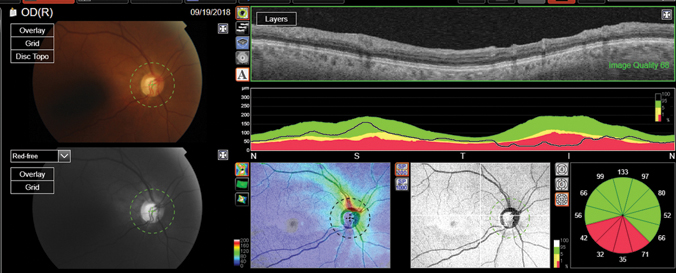Swept-source OCT offers clinical, practical advantages

Swept-source OCT is an exciting new technology with useful applications in both posterior and anterior segment disease management.
As an early adopter of swept-source OCT (SS-OCT) in the U.S., our practice has used it for the better part of a year, and my colleagues and I are impressed by the image clarity, scanning speed, and patient and practice benefits SS-OCT provides.
Fast, quality images
SS-OCT’s primary benefit and clinical advantage is the speed and quality of image capture. Our device consistently produces high-quality images, even under challenging conditions.
As a glaucoma specialist, I often encounter patients with cataracts and, occasionally, patients with vitreous hemorrhage. Our previous spectral domain OCT (SD-OCT) device, while capable of producing quality scans, occasionally suffered image fidelity loss in these circumstances. With SS-OCT, however, image quality is preserved even in the presence of opaque media and difficult imaging conditions, helping my colleagues and me diagnose with confidence. For those managing a high volume of patients with posterior segment disease — such as age-related macular degeneration or diabetic macular edema — the value of consistently clear imaging cannot be overstated.
Multimodal benefits
The multimodal nature of next-generation diagnostic devices, including swept source devices, is also immensely beneficial. I frequently use my SS-OCT device to acquire retinal nerve fiber and ganglion cell layer scans, which can be captured alongside fundus photography and B-scans for a dynamic assessment of relevant physiology.
Additionally, our SS-OCT device captures wide-field scans across a 12 mm by 9 mm field, allowing me to visualize and analyze the optic nerve and macula using a single scan.

Source: Michael Chaglasian, OD
Gentle light source
Our SS-OCT device uses a 150 nm light source to capture visual feedback. Compared to our previous SD-OCT device, the light source is gentler on patients’ eyes, which is important for two reasons. First, less disruption allows the patient to sit still during imaging, which is one of several factors facilitating SS-OCT’s consistently clear image quality. Second, it makes for a better patient experience, which is valuable under any circumstance.
SS-OCT’s inherent speed, image quality and patient comfort help optometrists arrive at accurate diagnoses faster and more reliably, which is crucial as we strive to see more patients and practice better medicine. In my own day-to-day practice, it is imperative that I quickly identify any areas of abnormality in the retinal nerve fiber or ganglion cell layer, and swept source makes the process far more efficient.
Dynamic software
Beyond the technological capabilities of image capture itself, next-generation OCT devices are offering practitioners incredible, dynamic software suites that make image management easier and highly rewarding.
Our system’s software, for instance, helps us produce a comprehensive case report that collates B-scans, fundus photography, topographical scans and other captured images in one location. The software references captured images against a validated normalized database and automatically highlights perceived abnormalities. This feature helps my colleagues and me identify abnormalities and diagnose with incredible efficiency, as our digital resource helps steer us toward clues and markers that might otherwise take considerably more time to find.
Finally, having all these quality images collated in one location improves patient education and communication. We find that patients understand their diagnosis better when we are able to illustrate their physiology using different types of images, all of which can be captured on our device and easily exported for display on external monitors in our exam room.
Case study
A new 65-year-old male patient presented for a comprehensive eye exam, with a chief complaint of difficulty reading. Best corrected vision was 20/60 OD, 20/25 OS. His family history was positive for glaucoma (maternal side). Slit lamp exam (dilated) showed a 3+ cataract in the right eye. Tonometry measured IOP of 23 mm Hg OD and 20 mm Hg OS. Central corneal thickness was 530 microns OD and OS. Based on these findings, an evaluation for glaucoma was scheduled (prior to planned cataract/IOL surgery).
A visual field test identified no defects except for a generalized depression. Our SS-OCT device (Swept Source DRI OCT Triton, Topcon) clearly found a significant inferior retinal nerve fiber layer (RNFL) defect in the right eye consistent with glaucoma. The left eye was normal. Scan quality was high despite the dense cataract. Glaucoma treatment was initiated, and the patient proceeded to cataract surgery. Monitoring will continue with OCT and visual fields.
The price tag associated with new capital equipment can be daunting. Effective practice management means taking time to weigh and consider the pros and cons of new technologies, choosing meaningful acquisitions over incremental upgrades. In my mind, SS-OCT should be considered the former, especially for practices treating a large volume of glaucoma and posterior segment patients. Image clarity leads to accurate diagnosis, which is invaluable. – by Michael Chaglasian, OD
For more information:
Michael Chaglasian, OD, is an associate professor and chief of staff at Illinois College of Optometry in Chicago and the president of the Optometric Glaucoma Society. He can be reached at: mchaglas@ico.edu.
Disclosure: Chaglasian reports he is a consultant for Topcon Medical.
